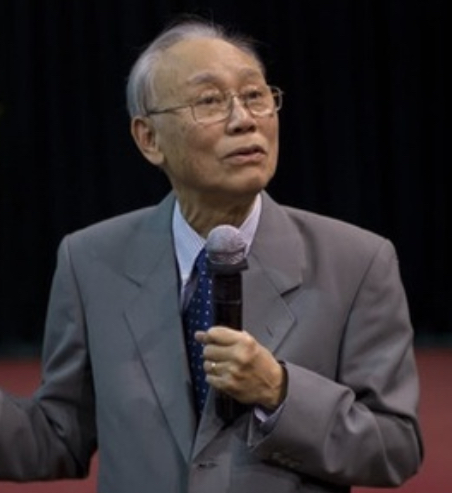 Nguyen Quang Rieu (Photo credit: Vjisonline.org)
Nguyen Quang Rieu (Photo credit: Vjisonline.org)
Nguyen Quang Rieu
Contributed by James Lequeux
Nguyen Quang Rieu passed away in Paris on 5 January 2021, from COVID-19. Born on 4 January 1932 in Haiphong in northern Vietnam, Rieu, as we familiarly called him by his first name, completed his secondary education in Hanoi. He came to France in 1950 to study at the University of Paris. The war in his country led him to settle permanently in France. He obtained a position at the University and later at the CNRS.
Rieu began working at the Paris Observatory in 1966, when the large radio telescope of the Nançay radioastronomy station started operation. He first observed normal galaxies in the continuum at 21 cm, then determined the distance of the Cygnus-X3 X-ray source, which is also a variable radiosource, by observing the 21 cm line of hydrogen in absorption in front of it. For this rather exceptional observation, he received a prize from the French Academy of Sciences. But he finally found his way when, in 1971, a receiver for the four 18-cm lines of the OH molecule, built in collaboration with the Sternberg Institute in Moscow, was installed on the Nançay radio telescope. He then discovered the maser emission of OH in the envelope of many evolved giant stars, the OH-IR stars, and participated in the elaboration of the theory of this emission, which involves pumping the maser levels by the infrared continuum emitted by the star.
Much appreciated by his colleagues around the world, he established close collaborations with radio astronomers and molecular physicists from Germany, the United States, England, China and Japan, and obtained observations with instruments as varied as the 100m Effelsberg and 30m IRAM radio telescopes, the Very Large Array, the IRAM and BIMA millimeter interferometers, not forgetting some VLBI observations. This enabled him to extend its activity to interstellar molecules in general, mainly in circumstellar envelopes, planetary nebulae and external galaxies (especially their OH megamasers). He also used extensively the Long Wavelength Spectrometer (LWS) of the European infrared satellite ISO, thus complementing his observations in the radio domain. He has published no less than 20 collaborative papers based on the results obtained with this instrument. He had clearly become one of the world's leading specialists in the matter.
Rieu never cut the bridges with Viet Nam, where he returned regularly from 1976. He was at the origin of an official collaboration between the Paris Observatory, the French Pierre and Marie Curie University and the National University of Hanoi, set up in 1995. This collaboration, which involves both research and teaching, is still active. Within this framework, Rieu has been able to obtain scholarships allowing young Vietnamese astronomers to come to France to do their PhD thesis at the Paris Observatory, most often under his direction. They all returned to Vietnam where they formed a research group, which is very active at present. Rieu has given numerous lectures in Hanoi and Ho Chi Minh City and has written several books in Vietnamese popularizing astronomy, as well as an English-Vietnamese bilingual textbook in physics.
Nguyen Quang Rieu was a warm and modest man, but with an iron will that allowed him to make great achievements in research, teaching and collaboration between France and Vietnam. He will leave a lasting memory to those of these two nations who have known him, as well as to his colleagues around the world.
![[IAU logo]](iau_wb_thumb.jpg)
![[URSI logo]](URSI-logo-thumb.jpg)
![[Karl Jansky at his antenna]](jansky_photo_02_thumb.jpg)
![[Reber's Wheaton antenna]](Reber_Telescope_Wheaton_thumb.jpg)
![[Dover Heights]](Dover_Heights_02_thumb.jpg)
![[4C telescope]](GB61-195_4C_telescope_thumb.jpg)
![[Ewen and horn antenna]](ewen_horn1s.jpg)
![[Dwingeloo, 1956]](Dwingeloo-1956-thumb.jpg)
![[Jocelyn Bell Burnell and Cambridge antenna used in pulsar discovery]](burnell2_thumb.jpg)
![[Lovell Telescope at Jodrell Bank]](site_1594_0001-500-334-20180316163019-thumb150.jpg)
![[Wilson, Penzias, and Bell Labs horn antenna]](wilson-penzias-horn_thumb.jpg)
![[6-m Millimeter Radio Telescope in Mitaka, Japan]](6m-thumb.jpg)

